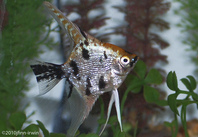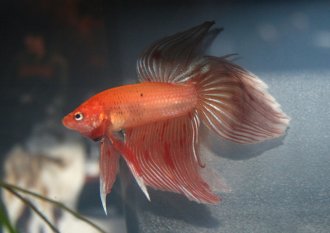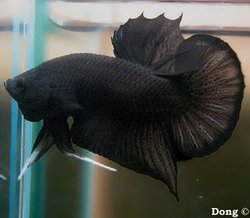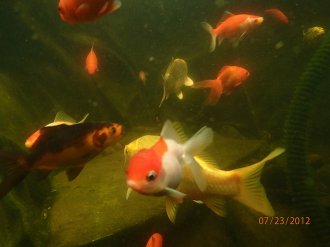

Fish
Petland carries a wide variety of all types of fish: tropical, fresh water, gold fish, and betta fish. Petland is the place for all of your aquarium and water garden needs. We can help you with your fish selection, aquarium design, and ensure compatibility with any existing fish in your tank. Our fish experts will be there with you the entire time.
Once your new aquatic habitat has been installed, we are able to keep it looking great with our onsite maintenance crew. We can clean, care for and stock your aquarium or water garden taking the hard work out of your hands so you can enjoy your new fish and aquarium.
Fresh Water Fish
Betta Fish
Pond Fish
Gold Fish
Fish are a great "starter pet" to teach kids the responsibility of taking care of a pet. Fish come in an enormous variety of sizes, shapes and stunning, vibrant colors. Some types of fish interact with their owners, are playful, and can even be trained to do tricks. Fish are known to have a tranquil, calming effect on anyone who watches them glide serenely through the water.
 Fish Supplies
Fish Supplies
Behavioral
Decorations– Structure helps provide security and safety to fish. Decorations will reduce stress, aggression and sometimes visually enhance the aquarium.
Plants –Provide niches for mid-water and surface swimmers.
Driftwood, Castles, Rocks– Provide cover for bottom-dwelling species.
Schooling –Most of the fish we keep in aquariums live in groups called schools. It is important to keep them in groups of at least three of the same species.
Aquarium Background– Helps Improve the look of the aquarium and helps provide a sense of security for the fish.
Maintenance
Gravel Cleaner– Helps keep a tank clean, helps remove waste buildup, and facilitates water changes.
Filter Material– Replaceable filter cartridges that help keep the tank clean and help remove particles from the water.
Net – Helps catch adult and baby fish with least amount of harm
Algae Scraper– Safest way to clean aquarium glass - Use the appropriate pad for your aquarium (glass or plastic).
Test Kits – Help Monitor water quality parameters – several to choose from
 Environmental
Environmental
Aquarium –The larger the tank, the better your success and the happier the fish.
Hood/Light –Allows light to illuminate to the fish and plants for enhanced growth and enjoyment. Fluorescent lighting is still more popular than LED and incandescent
Canopy – Helps Hide cords and helps make presentation clean and uncluttered.
Stand –Safely supports the weight of the aquarium and meets the warranty requirements.
Filtration Systems –This is the life support system – the three types of filtration are chemical, biological, mechanical. Biological being most important.
Heater and Thermometer– Provides a stable temperature, which reduces stress and disease.
Water Conditioner– allows removal of toxic chemicals such as chlorine.
Substrate – Used for decorating, it also allows nitrifying bacteria to adhere to, which promotes biological filtration.
Bubbles and Air Accessories – Oxygen enters the aquarium primarily from the surface. Bubbles will allow surface agitation and increased gas exchange.
Stress Aid –During the process of traveling, fish endure a great deal of stress, making them more susceptible to disease. Helping manage the stress will reduce the chance your fish will get sick.
 Nutritional
Nutritional
Food – Must be offered in proper form for fish to eat (flake, pellet, disc, etc.). Offer A variety of food that mimics their natural environment.
Staple Diet– Provides basic nutrition. Typically flake.
Plant Based Diet– Helps Provides roughage, good for omnivores (Live-bearers, Tetras, Barbs, etc.).
Frozen Food– Helps Provide a variety of balance, a must for certain fish
Common Myths About Fish
#1- The more fish, the better!This is absolutely false. Overcrowding your tank, one of the mistakes made most often by first-time aquarists, is a recipe for disaster. One of the most common stocking errors is to fill a 5-gallon tank with upwards of 30 fish—yikes! Like people, fish need room to move. There also needs to be enough oxygen available for all of the fish you put into your tank. When stocking your tank, think "less is more."
#2- The smaller the tank, the easier it is to keep. Many people believe that a small tank will be less trouble: it will contain less fish, take less time to clean, and generally be less of a commitment. Well, the truth is, a smaller tank will be just as hard—if not harder!—to maintain as a large tank. In fact, many large tanks are actually easier to care for because, if a problem arises, you'll have a bigger window of time to try to solve it before disaster becomes inevitable. A smaller tank, on the other hand, can quickly be overtaken by algae, disease, or a variety of other things. Also, it is much easier to maintain appropriate levels of pH, alkalinity, etc, in a larger tank because fluctuations will be minimal and easier to stabilize.
#3 Taking care of a tank of fish is a walk in the park compared to caring for a dog or cat.Sure, your fish won’t wake you up in the middle of the night to be let outside. And your fish won’t scratch claw marks into all your favorite furniture. But fish certainly have their own set of needs, and taking care of them can actually be more challenging than caring for a dog or cat simply because they are unable to let you know when they need something. If you think you want a fish tank, make sure you’re ready for the commitment and not just looking for an "easy" pet.









